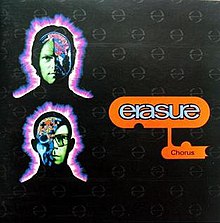Chorus (Erasure album)
| Chorus | ||||
|---|---|---|---|---|
 |
||||
| Studio album by Erasure | ||||
| Released | 14 October 1991 | |||
| Recorded | 1989-1991 | |||
| Genre | Synthpop | |||
| Length | 41:29 | |||
| Label |
Mute Records, Sire Records |
|||
| Producer | Martyn Phillips | |||
| Erasure chronology | ||||
|
||||
| Singles from Chorus | ||||
|
||||
| Professional ratings | |
|---|---|
| Review scores | |
| Source | Rating |
| Allmusic | |
Chorus, Erasure's fifth proper studio album, was released by Mute Records in the UK and Sire Records in the U.S. in 1991 (see 1991 in music); and on the short list of nominees for the 1992 Mercury Prize. In 1999, Ned Raggett ranked the album at number 45 in his list of "The Top 136 or So Albums of the Nineties".
Upon its release, Chorus became Erasure's third consecutive number-one album in the UK and gave them four more top twenty hits. In the U.S., it was Erasure's highest-debuting and highest-peaking album on the Billboard 200 at the time, entering at #29. It gave Erasure their first Billboard Hot 100 entry since "Stop!" with the title track, which also charted well on the Modern Rock Tracks chart and Billboard's Hot Dance Music/Club Play chart. Chorus also charted well in Germany, where it peaked at number thirteen.
Prior to the album's production, programmer Vince Clarke had noticed technical limitations of the by-then-predominant MIDI sequencing standard, notably that the protocol's low signal rate resulted in timing errors (known as "MIDI slop") when multiple notes were triggered simultaneously. In an effort to eliminate this and give the album a "tighter" feel, he avoided the use of MIDI completely, using primarily analog synthesizers and the Roland MC-4 CV/gate sequencer. The avoidance of MIDI had other side effects on the sound of the album, such as the lack of chorded voices (the MC4 can only trigger one note at a time per instrument) and digital synthesizers and samplers, due to lack of CV/gate interfaces on available models. Clarke would continue with this production technique for later recordings through the 90s.
Chorus was also released as a limited-edition CD in special packaging. Instead of a jewel case, it came in a folding cardboard box. The cover was also different, with the two portraits taken from the side instead of the front, as on the cassette releases. It included the standard lyrics booklet, as well as 8 picture cards with various artwork. The first four are the stock photography from the booklet and have "e" logo backs: family on the beach (later used for the "Love to Hate You" single cover), a business meeting group, three businessmen at a construction site, and a woman and child bicycling. The next four are the portraits from the album cover, one each of Clarke and Bell from the front and side. The backs of these have patient data from Clarke and Bell's MRI scans.
...
Wikipedia
